New Data on the Remote Employee Experience, and How to Improve It



Employers may not know how to best engage and support their new work from home employees. So, we surveyed thousands of remote workers around the globe on their experience and offer tips.

Conor Donegan
Every two weeks, Salesforce Research is surveying the general population to discover how consumers and the workforce are navigating the COVID-19 pandemic. We’re posting the insights we’ve found, and tips on what businesses can do in response. Click here to explore data across demographics and geographies.
For many professionals, the nature of work has been turned on its head. Sixty-two percent of the U.S. workforce is working remotely — 80% of whom started doing so since the onset of the COVID-19 pandemic. All of a sudden, leaders must ask how to equip, empower, communicate with, motivate, and care for geographically scattered employees who are, at the same time, dealing with an unprecedented crisis that impacts their personal lives. Given rising interest in long-term remote work, the actions taken now could have far-reaching implications.
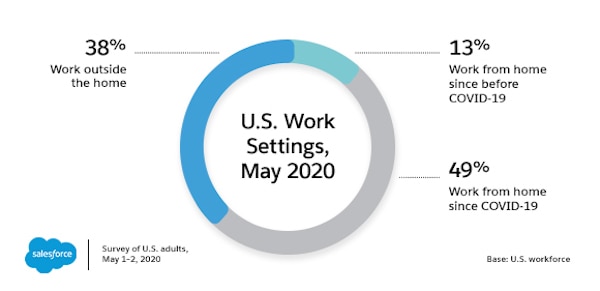
We surveyed a broad base those working remotely — either by choice or otherwise — about their productivity, the resources they have, and what actions their employers can take to engage and care for them during this difficult time.
Here are some key findings and tips.
Step up communication
It may seem obvious that clear and consistent communication is the basis of any successful remote work culture. Yet making this a reality is easier said than done. Eighty-seven percent of remote workers in the U.S. consider regular communication from company leadership to be important, yet only 32% say their employer has expanded or increased the frequency of executive update emails, all-hands calls, and the like.
Leaders have the opportunity to instill a sense of stability, care, and common purpose through regular communication. Clear and timely updates on shifting goals, initiatives, and progress are extraordinarily valuable, but so are less obvious topics such as reliable sources of information about the crisis — or even an open and frank discussion of personal vulnerability to remind employees that we’re all in this together.
Effective communication among work groups is just as critical for productivity and morale, but just 40% and 36% of U.S. remote workers rate their communication with colleagues and managers as excellent, respectively. Managers can make a big difference by prioritizing both regular check-ins and team get-togethers. The goal shouldn’t be to add meetings for their own sake, but rather to foster the steady cadence of open and clear conversations that happen in person.
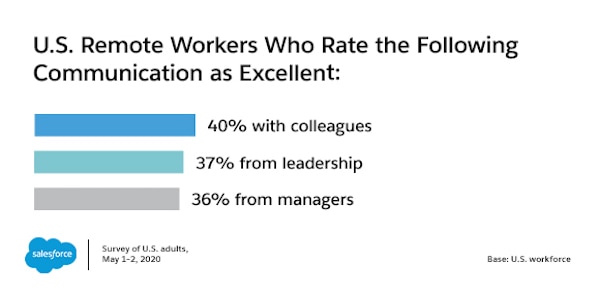
Polling teams on the right cadence of meetings, the topics to cover, and the right medium go a long way towards instilling a great culture of communication regardless of where team members sit.
Equip employees for remote success
A mere 17% of U.S. remote workers say they are less productive than they were in the office. At the same time, only 42% rate their current productivity as excellent, calling into question how effective business as usual was in the first place. The rapid shift in workplace settings presents an opportunity to improve the status quo.
Only 38% say their employers have provided excellent hardware such as desks, peripherals, and the like. While furnishing home offices isn’t likely to be in budget, employers can still show they care for worker wellbeing by proactively sharing tips on home office best practices.
Physical spaces are only part of the remote work equation, of course. A mere 39% of U.S. remote workers say they have excellent software or apps from their companies. Several tech companies, including Salesforce, are offering product trials for free, providing companies with no risk opportunities to try different solutions, and identify what best meets their shifting needs. Just 32% of U.S. remote workers say they’ve tried new technologies or apps for the first time while working remotely, indicating ample room for experimentation.
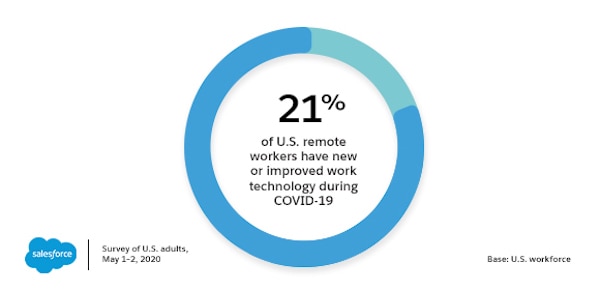
Keep professional development on track
Productivity isn’t the only objective for a remote workforce: so is development. Fifty-three percent of the U.S. workforce wants a better or more up-to-date skill set, and 56% say their employers have provided the training to keep their know-how up-to-date. Maintaining a culture of learning among a distributed workforce is essential for both keeping employees on an upward trajectory as well as business competitiveness.
Encouraging employees to develop a V2MOM — Salesforce’s method for defining individual and team objectives, success measures, and tactics — is a great start. Providing development resources like Trailhead is another way to help employees make sure their progress doesn’t stall, but a demonstrated interest in their development — such as helping to define milestones, removing blockers, and keeping accountability — are arguably the most important steps a manager can take.
Embrace flexible schedules and operations
Everyone is experiencing this crisis differently, and a one-size-fits all approach to employee engagement can be ineffective at best. Demonstrating an understanding of employees’ unique circumstances, and providing the resources to produce their best work without neglecting family and personal needs, is critical.
In fact, 88% of the U.S. workforce cites flexible work schedules as an important step by employers at this time. This can be especially important for working parents who find themselves as full-time caretakers and educators while doing their regular job. Just 38% of these workers, however, say their employers have offered increased flexibility. Leaders who proactively address the potential need for flexibility, and demonstrate a willingness to work with employees in updating schedules, workflows, and the like to match new realities, will go a long way in earning trust.
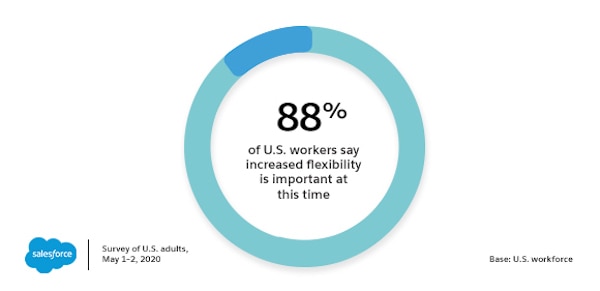
Pay attention to mental health
Physical health is a primary topic of concern in our current environment, and for good reason. But as the strain of uncertainty, stress, and isolation persist, mental health needs attention, too. In fact, 70% of Americans we surveyed cite mental health concerns — a figure that rises to 85% for Gen Z and 81% for millennials.
The workforce is far from immune from this issue, and employers may be understandably at a loss for how to provide support; just 22% of the U.S. workforce report having received mental health resources from their employers as a result of the pandemic.
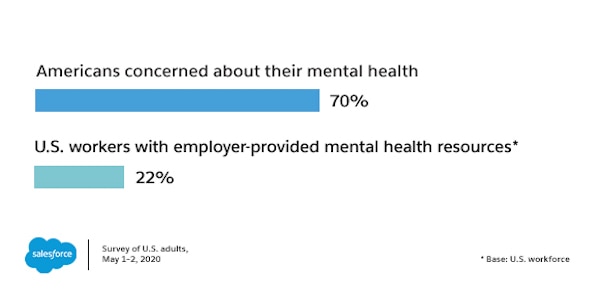
In order to address these concerns, employers should evaluate their well-being benefits and programs to make sure they’re meeting the unique needs of the workforce during this time. At Salesforce, for example, we launched a live webinar series, called B-Well Together, for employees, the community, and experts to discuss well-being. We also introduced a global benefit program, called Thriving Mind, in partnership with Thrive Global and Stanford Medical, to help employees and their families strengthen their psychological and emotional health.
For more insights on employee experience during these challenging times, among other topics, check out our interactive research dashboard. For additional data-driven resources on leading through change, visit the Tableau COVID-19 Data Hub.
Methodology
Data mentioned in this article is from a double-blind survey of the general population, a subset of which consisted of full- and part-time employees in the United States, United Kingdom, France, Germany, Brazil, and Australia. Data was collected from May 1 to May 2, 2020 and yielded 3,542 responses. Data is weighted to accurately represent the general population.























